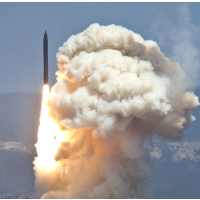Missile Defense Program Accused of Wasting $40 Billion
 Test launch of MDA's ground-based interceptor, 2014 (photo: Getty)
Test launch of MDA's ground-based interceptor, 2014 (photo: Getty)
By Carter Salis, Project on Government Oversight
Don’t throw good money after bad. It seems like common sense, but a recent report from the Union of Concerned Scientists (UCS) reveals that common sense is not necessarily common at the Department of Defense (DoD). After 15 years and $40 billion in taxpayer dollars, the DoD’s Missile Defense Agency (MDA) has come nowhere near producing a reliable missile defense system.
The development of the Ground-based Midcourse Defense (GMD) missile system began in 2002 with an initial goal of operational capability by late 2004. Today, the GMD system has a pitiful test record and no demonstrated ability to stop an incoming missile under real-world circumstances.
Ideally, the GMD would destroy an intercontinental ballistic missile (ICBM) before it could reach the mainland United States. The basic concept behind anti-ballistic missile technology is that radar monitors would detect a missile launched from a threat nation, and a missile interceptor would launch from the United States and detonate that missile before it re-enters the atmosphere. The GMD system would present a relatively comprehensive missile defense plan, except for the fact that there is no consistent evidence to suggest that the system actually works.
UCS explains that the MDA is exempt from standard acquisition rule DOD5000 and from reporting obligations required for other major defense programs. By circumventing all appropriate oversight channels, the Pentagon has permitted the GMD system to advance without an estimated total budget.
Following the attacks of September 11, 2001, President George W. Bush announced the United States’ withdrawal from the Anti-Ballistic Missile Treaty and, citing the need to protect against rogue nations such as North Korea, expedited the GMD project. The Pentagon substituted the “fly before you buy” acquisition protocol for a highly concurrent schedule, during which technology development, product development, and actual production occurred simultaneously. In January 2002, Defense Secretary Rumsfeld allowed the MDA to develop its own requirements, to evaluate its own performance against these requirements, and to consolidate, establish, and cancel programs at will without external oversight. As the UCS report details, “This exemption allowed virtually all MDA expenditures to be classified as research and development (R&D) funds, which are not subject to the same levels of oversight as procurement or construction funds.”
At the time, Pentagon officials explained that the experimental nature of the missile defense program rendered it nearly impossible for them to provide cost or schedule estimates. Some Members of Congress were skeptical when asked to write a blank check. “You get the suspicion this is as much to avoid scrutiny of the program as to shield it from adversaries,” said Senator Jack Reed (D-RI).
In September 2004, the Bush administration claimed that the national missile defense program had achieved “limited deployment option” capability. However, it was not until September 2007, approximately three years after announcing initial launch capability, that the first successful destruction of a test target by an interceptor missile occurred.
Two types of kill vehicles were developed for the GMD system, the CE-I and CE-II, which were both fielded before any operational capability had been established by test flights. What is worse, in more than half of all intercept tests the GMD interceptors were incapable of destroying their target. The success rate has not improved over time. The failure of a CE-II kill vehicle in 2010 prompted a Department of Defense Inspector General report that exposed various breaches in the quality control processes at Boeing (the lead contractor for the interceptor) and Raytheon (the kill vehicle manufacturer), which were substantial enough to call into question the operability of GMD interceptors. According to UCS, the issue was later determined to be a systemic problem—a track gate issue—that, had there been proper oversight mechanisms to ensure quality production, “might have saved a year of development time and a significant amount of money.”
Testing GMD interceptors is an expensive and laborious process, one the Pentagon has attempted to circumvent by conducting computer simulations that model the expected behavior based on tests of subsystems and individual components. Quoting Dr. Michael Gilmore, Director of Operational Test and Evaluation, UCS writes, “The modeling and simulation, although it’s essential, basically assumes that the kill vehicles will function mechanically, for lack of a better way to put it, the way that they’re supposed to.”
With the price of the GMD program being augmented to egregious sums, the cost of eliminating oversight processes has only become more apparent. As UCS explains it, “There is no compelling reason that a system intended to protect against nuclear weapons should not be held to standards at least as high as a system intended to deliver them.”
Ultimately, the taxpayer funded GMD program has resulted in an excessive expenditure with no recorded operational capacity. The GMD acquisition process demonstrates the potential for waste when political priorities and contractor interests take precedence over technical capability and good governance. Fifteen years and $40 billion later, we are left with an unreliable anti-ballistic missile system and a gaping hole in our pockets.
For a more detailed account of MDA’s wasteful and irresponsible acquisition practices, please read the complete report by the Union of Concerned Scientists.
To Learn More:
Missile Defense Agency Spent $10 Billion on 4 Projects that were Cancelled (by Noel Brinkerhoff, AllGov)
Another Missile Defense Test, Another Failure (by Matt Bewig, AllGov)
- Top Stories
- Unusual News
- Where is the Money Going?
- Controversies
- U.S. and the World
- Appointments and Resignations
- Latest News
- Trump to Stop Deportations If…
- Trump Denounces World Series
- What If China Invaded the United States?
- Donald Trump Has a Mental Health Problem and It Has a Name
- Trump Goes on Renaming Frenzy






Comments